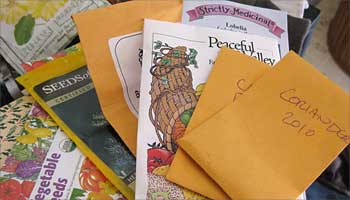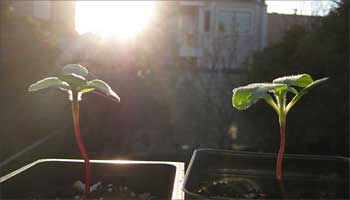Where Do Your Seeds Come From? 1
I have long been a proponent of saving and exchanging seeds and small regional seed companies, but recently I was shocked by two news stories in the world of commercial seeds. The first was the purchase of two of the largest seed suppliers in the country by Monsanto: Seminis, purchased in 2005, controlled 40% of the U.S. seed market at the time, and De Ruiter Seeds Group BV, a large Dutch vegetable seed breeder in 2008. This feels pretty ominous to me, that Monsanto, with their “copyright everything that exists” policy, should have such a large control over our seeds.
The second piece of news, which was more recent, was the discovery of a newly discovered pathogen that exists in much higher concentration in Roundup Ready soybeans and corn that may be responsible for “significant harm” to both plants and animals.
In a letter to Secretary of Agriculture Tom Vilsack in January 2011, Dr. Don Huber, professor emeritus at Purdue University called on the federal government to immediately stop deregulation of roundup ready crops, particularly roundup ready alfalfa. The full text of the letter can be found on the Farm and Ranch Freedom Alliance website.
It’s too early to tell what’s happening with this pathogen, but I don’t like anything about seeds that might be modified, but aren’t labeled as such, or, seed companies that might sue me if I harvest seed that I’ve grown. I feel a rant coming on, but I’d rather focus on the alternatives.
Reading this gave me a new impetus to scrutinize all my seeds and check out their origins.
The Council for Responsible Genetics has created a safe seed pledge, which reads:
“Agriculture and seeds provide the basis upon which our lives depend. We must protect this foundation as a safe and genetically stable source for future generations. For the benefit of all farmers, gardeners and consumers who want an alternative,
We pledge that we do not knowingly buy or sell genetically engineered seeds or plants.
The mechanical transfer of genetic material outside of natural reproductive methods and between genera, families or kingdoms, poses great biological risks as well as economic, political, and cultural threats. We feel that genetically engineered varieties have been insufficiently tested prior to public release. More research and testing is necessary to further assess the potential risks of genetically engineered seeds. Further, we wish to support agricultural progress that leads to healthier soils, genetically diverse agricultural ecosystems and ultimately healthy people and communities.”
Here is the most recent list (2010) of companies who have signed the pledge.
My seeds checked out pretty well. All of the commercial seed came from vendors who had signed the safe seed pledge. Some companies also test for contamination as well.
The first place I ever visited that was completely devoted to growing seed was Peace Seeds in Oregon. What a magical place! What a different kind of garden it is too, that’s devoted to letting crops go to seed. At the time, the Abundant Life Seed Foundation, based in Washington, was also a pioneer in the seed saving movement, but Abundant Life was destroyed by a fire, with countless varieties lost forever.
In researching this post, I found that part of Abundant Life had evolved into the Organic Seed Alliance, which is committed to “creating farmer-centric, regenerative, regional seed systems, that not only conserve diversity, but create new diversity.”
So out of a tragic fire, the move towards a more local option.
It makes sense to save seed in your community, cause the seed will grow better for you, and it also decentralizes seed banks, so if seeds are lost, only some of them are lost. Now there are many more small, grassroots seed exchanges, sometimes, just a seed-exchange night or party. Sometimes you even get to meet the people who harvested your seeds, and hear the story of what you’re going to plant. And you get to barter, which makes so much more sense. How many of us are left with seed we don’t use?
I collect many seeds for native and ornamental plants in my walks through the Bay Area, get some from friends, and buy some. (I’m a sucker for some beautiful seed packets) But I haven’t availed myself of the more organized seed exchanges.
BASIL, the Bay Area Seed Interchange Library, is a close one that’s located at the ecology center in Berkeley.
Here’s a video that explains how it works, it’s pretty cool to get a glimpse of how it’s organized. Easy to hard, planting time, plant family, categories:
I want to check it out. But there are some other opportunities that are even closer to me.
I recently heard that the Potrero Branch of the San Francisco Library is piloting a new program in partnership with The Seed Library. It sounds like it will work like a seed exchange. I do have seeds I need to exchange while they are still viable, so I will plan a trip there soon and report back.
Do you have favorite local seed exchanges? Feel free to post them in the comments.



In Los Angeles, about 80 people are striving to establish the Seed Library of Los Angeles, the first seed library in LA. Personally, I support Native Seeds/SEARCH and Seed Savers Exchange. Botanical Interests and Peaceful Valley Farm Supply have also signed the Safe Seed Pledge.